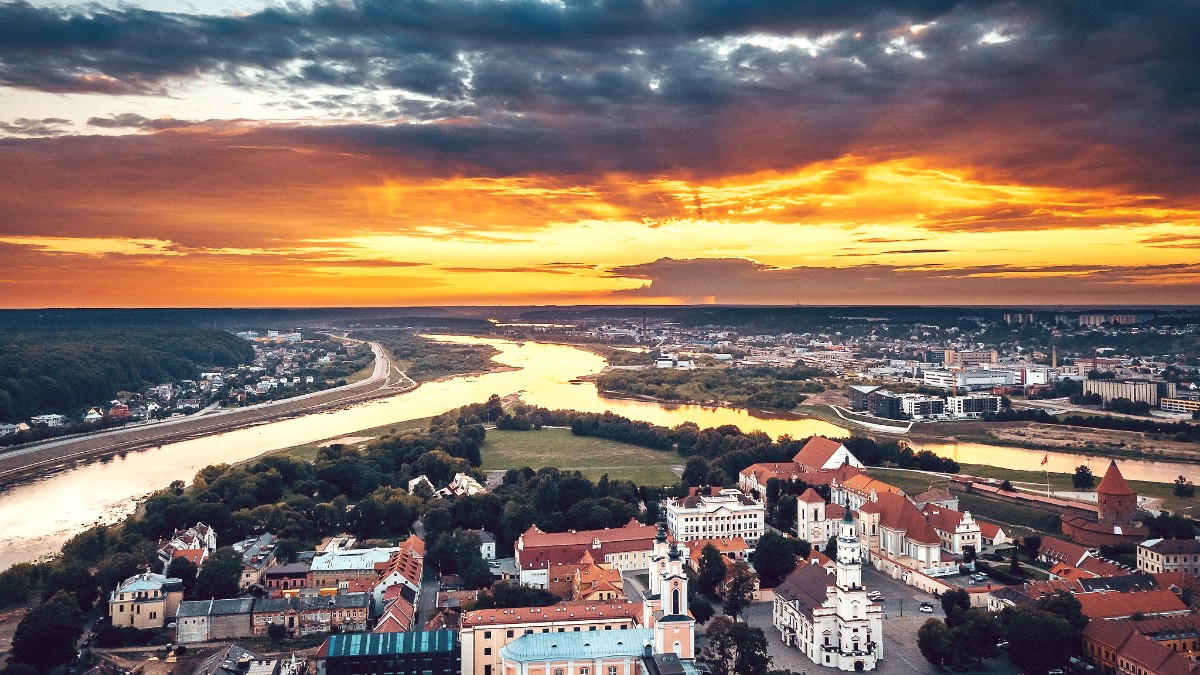
Central Lithuania, Lithuania
Kaunas is a special place on Lithuania’s map, positioned in the heart of the country. It sits approximately 100 kilometers, or about 62 miles, west of Vilnius, the national capital. This location makes Kaunas accessible and a natural hub within the country.
The land around Kaunas presents a relatively flat to gently rolling landscape. This terrain is typical of the central Lithuanian lowlands, characterized by fertile agricultural fields, patches of dense forest, and numerous small lakes and rivers. Visitors often appreciate the ease of movement within the city due to this relatively flat topography, making exploration by foot or bicycle pleasant.
The story of Kaunas begins in the 14th century, when its strategic location at the confluence of the Nemunas and Neris rivers made it a major trade center. Merchants traversed these waterways, bringing goods and ideas, which fostered city growth. Its early development was tied to the Grand Duchy of Lithuania, a powerful state that once spanned a large part of Eastern Europe. Kaunas stood as an important defensive outpost against the expansion of the Teutonic Knights, who frequently launched incursions into the region. The remains of Kaunas Castle, dating from this period, attest to these early struggles and the city’s enduring role in safeguarding Lithuanian lands.
A unique period for Kaunas arrived between 1920 and 1939. During these two decades, with Vilnius under Polish control, Kaunas served as the provisional capital of the newly independent Republic of Lithuania. This era witnessed an extraordinary flourishing of architectural and cultural activity. The city underwent rapid modernization, and its unique interwar modernist architecture became a symbol of national pride and a desire to connect with contemporary European trends. Buildings from this period, often characterized by clean lines, functional designs, and a blend of Art Deco and Lithuanian National Romanticism, populate the New Town. This architectural legacy gained recognition, including the prestigious European Heritage Label, drawing architects and history enthusiasts from around the world.
Strategic trade center at river confluence, defensive outpost.
Part of a multi-ethnic union, fostering cultural exchange.
Provisional Capital, interwar modernist architecture flourished.
Occupations by Nazi Germany and Soviet Union, resistance.
European Capital of Culture, revitalizing cultural scene.
The mid-20th century brought further challenges. Kaunas experienced the brutal occupations of both Nazi Germany and the Soviet Union. Despite these oppressive regimes, the city continued its quiet but enduring role in Lithuania's independence movements. Its citizens participated in acts of resistance, preserving their national identity and language under difficult circumstances. The city’s history includes poignant reminders of these dark times, like the Ninth Fort, a site of mass killings during World War II, which is now a memorial and museum.
Its designation as an European Capital of Culture in 2022 brought renewed focus and investment, revitalizing its cultural scene and drawing international attention. This title helped showcase the city's unique history, its artistic endeavors, and its forward-looking spirit.
Its story reflects the journey of an entire nation, marked by resilience, cultural growth, and a persistent drive for freedom.
Kaunas, a city of layered history and future, invites exploration.
Kaunas, the second-largest city in Lithuania, presents a compelling mix of history, culture, and modern energy. It has visitors a distinct urban experience, shaped by its role as a provisional capital and its status as a hub for education and industry.
The city's unique architectural landscape is one of its standout features. Kaunas is especially known for its interwar modernist architecture. This collection of buildings, constructed during the period when Kaunas served as Lithuania's provisional capital, represents an unique fusion of global architectural trends with local sensibilities. These structures, often characterized by clean, functional designs and a distinct aesthetic, received the European Heritage Label, recognizing their outstanding value. You will see a cohesive urban fabric that tells a story of a nation building its identity.
European Heritage Label recognition.
Large student population creates a dynamic atmosphere.
Center for technology and business in Lithuania.
Beyond its buildings, Kaunas boasts a rich cultural scene. The city has numerous museums, each exploring different facets of Lithuanian heritage and global art. The M.K. Čiurlionis National Museum of Art showcases the works of Lithuania’s most famous painter-composer. The Devil’s Museum has a quirky and memorable collection of devil figurines from around the world. For those interested in history, the Vytautas the Great War Museum details the nation's military past, and the Ninth Fort has a somber yet important look into wartime atrocities. Historical sites, including Kaunas Castle and the stunning Pažaislis Monastery, have glimpses into medieval and Baroque periods.